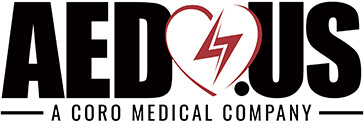At AED.US, our mission extends beyond merely supplying Automated External Defibrillators (AEDs) and Defibrillators. We are passionate advocates for life-saving techniques and education, with a particular emphasis on Cardiopulmonary Resuscitation (CPR).
One innovative method we champion is the use of music as a guide for CPR chest compressions. This method combines music and CPR to create a special and useful way of learning. It is based on the science of chest compressions.
Chest compressions are vital for CPR, helping to keep oxygenated blood flowing to the brain during heart emergencies. The American Heart Association advises a compression rate of 100-120 beats per minute (bpm). Interestingly, this rhythm is a common tempo in many popular songs, making them ideal aids for remembering and maintaining the correct compression rate.
The Role of Music in CPR
Music has a profound effect on our brains. It can reduce stress, boost brain chemicals, and even help us keep time. When applied to performing CPR, these benefits can potentially enhance the effectiveness of chest compressions.
The Metronome Effect
A metronome is a device used by musicians to maintain a steady tempo. During CPR, a song’s beat can help the rescuer keep a steady compression rate for effective chest compressions. In fact, studies have shown that using music during CPR can improve the quality of chest compressions. The rhythmic beat of a song can serve as a metronome, guiding the rescuer to maintain the recommended compression rate. This is especially helpful in high-stress situations where it can be easy to lose track of time and become fatigued.
Not only does music provide a steady rhythm, but it also has a calming effect on both the rescuer and the person receiving CPR. The familiar melodies and lyrics can help reduce anxiety and create a more focused and controlled environment. This, in turn, can lead to more effective chest compressions and increase the chances of survival for the person in need.
Furthermore, using music during CPR chest compressions can also help coordinate compressions and rescue breaths. Many songs have distinct changes in tempo or breaks, which can serve as cues for when to switch between compressions and breaths. This can prevent any confusion or hesitation, ensuring that the correct sequence is followed.
It’s important to note that the choice of music should be appropriate for the situation. Upbeat songs with a clear and consistent beat are ideal, as they can help maintain the desired compression rate. However, it’s crucial to avoid songs with lyrics that may be distracting or inappropriate for the situation.
Incorporating music into CPR can have numerous benefits. It not only helps maintain the correct compression rate but also reduces stress, improves coordination, and creates a more focused and controlled environment. So, the next time you find yourself in a CPR situation, don’t hesitate to turn on some music and let it guide you through the life-saving process.
The Power of Familiar Tunes During CPR
Familiar songs with the appropriate tempo can serve as excellent guides for CPR. As we mentioned above, they can help reduce the stress of the situation and increase the accuracy of compressions. We created a playlist of songs with beats that can potentially save lives. These beats align with the recommended compression rate of 100 to 120 bpm.
- “Stayin’ Alive” – Bee Gees (103 BPM)
- “Dancing Queen” – ABBA (100 BPM)
- “I Will Survive” – Gloria Gaynor (117 BPM)
- “MMMBop” – Hanson (104 BPM)
- “Girls Just Want to Have Fun” – Cyndi Lauper (120 BPM)
- “Respect”- Aretha Franklin (120 BPM)
- “Just Dance” – Lady Gaga, Colby O’Donis (119 BPM)
- “Something Just Like This” – The Chainsmokers, Coldplay (103 BPM)
- “Fly” – Sugar Ray (100 BPM)
- “Hips Don’t Lie” – Shakira (100 BPM)
- “Work It” – Missy Elliott (102 BPM)
- “Bye Bye Bye” – *NSYNC (118 BPM)
- “Wrecking Ball” – Miley Cyrus (120 BPM)
- “Love Lockdown” – Kanye West (120 BPM)
- “Up Up & Away” – Kid Cudi (120 BPM)
Empowering Through Education
Despite the simplicity of CPR, a staggering 70% of Americans report feeling helpless during cardiac emergencies. We believe that education is the key to change this. Learning CPR and understanding how to use an AED can make the difference between life and death.
AED Training and Assistance
At AED.US, we offer comprehensive training and assistance in the use of AEDs. Our team is dedicated to empowering individuals with the knowledge and confidence to act during cardiac emergencies.
Conclusion
In conclusion, the blending of music and CPR practice presents a fresh and effective approach to improving the outcomes of cardiac emergencies. At AED.US, we help people learn life-saving skills and provide the necessary training and resources for critical situations.
Check out our playlist here:

Written by Blaire Kingsmore
Customer Service Director
Fact checked by Phillip Woods, BA, NREMT-P, FP-C
Blaire attended the University of Tennessee where she graduated with a Bachelor of Science in Human Ecology- Child and Family Studies. She has been in the Automated External Defibrillator (AED) industry for over eight years and is the Director of Customer Service for Coro Medical. Blaire is also an American Red Cross-certified CPR/AED/First Aid Instructor, highly trained by each manufacturer on their specific AEDs, and knowledgeable regarding ALL State AED regulations and legislation.
“I know that every day I come to work, I am playing a part in saving someone’s life. I am passionate about these devices and am always looking for new and innovative ways to spread awareness and knowledge about Sudden Cardiac Arrest (SCA). I look forward to the day when everywhere I go, I will see an AED—when SCA will no longer take any lives.”
Last updated August 2nd, 2023





